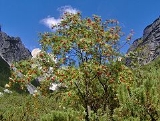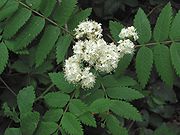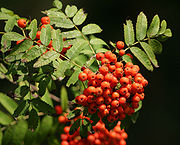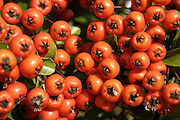
Sorbus aucuparia
Encyclopedia
Sorbus aucuparia is a species of the genus Sorbus
, native to most of Europe
except for the far south, and northern Asia
. In the south of its range in the Mediterranean region it is confined to high altitudes in mountains.
 Sometimes called "Mountain Ash
Sometimes called "Mountain Ash
", Sorbus is unrelated to the true Ash tree though the leaves are superficially similar.
It is a small to medium-sized deciduous
tree
typically growing to 8–10 m tall, more rarely 20 m, and exceptionally to 28 m. The bark
is smooth, silvery grey of young trees, becoming scaly pale grey-brown and occasionally fissured on old trees. The shoots are green and variably hairy at first, becoming grey-brown and hairless; the buds are conspicuous, purple-brown, and often densely hairy. The leaves
are pinnate
, 10–22 cm long and 6-12 cm broad, with 9–19 (most often 13–15) leaflets; each leaflet is 3–7 cm long and 15–23 mm broad, with a coarsely serrated margin; they are variably hairy, particularly the petiole and leaf veins on the underside. The hermaphrodite
flower
s are produced in large terminal corymbs 8–15 cm diameter with up to 250 flowers, the individual flowers 1 cm diameter, with five creamy-white petal
s, and are insect pollinated. The fruit
is a small pome
6–9 mm (rarely up to 14 mm) diameter, green at first, ripening bright red in late summer, and containing up to eight (most commonly two) small seed
s. It is diploid, with a chromosome
count of 2n=34.
Four or five subspecies
are recognised, for example:
 Rowan is very tolerant of cold and is often found at high altitude on mountains; in the UK
Rowan is very tolerant of cold and is often found at high altitude on mountains; in the UK
it occurs at up to 1 000 m altitude, higher than any other tree, and in France
up to 2 000 m.
It is very tolerant of a wide range of soil conditions, including thin acid soils and cracks in cliffs. It also fairly frequently grows as an epiphyte
in clefts or cavities of larger trees such as Scots Pine
s, though epiphytic specimens rarely have growing conditions adequate for them to reach maturity.
The fruit is an important food resource for many bird
s, notably Redwing
s, Fieldfare
s, Blackbirds, Mistle Thrush
es and Waxwing
s, which in turn disperse the seeds in their droppings. The seeds are eaten by Pine Grosbeak
s and other large finch
es.
The foliage and bark is eaten by Red Deer
, Roe Deer
, and Mountain Hare
s, and a small number of insect
larvae, including the moth
Venusia cambrica
, the case-bearer moth Coleophora anatipennella
and leaf-miners of genus Stigmella
. The snail Helix aspersa
also feeds on the leaves.
 Like other rowans, it is widely grown as an ornamental tree. Several cultivar
Like other rowans, it is widely grown as an ornamental tree. Several cultivar
s have been selected, including 'Asplenifolia' with very deeply serrated leaves, 'Beissneri' with coppery-orange bark and erect branching, and 'Fructu Luteo' with yellow fruit.
The fruit, called rowan berries
in culinary usage, are usually quite bitter, but are used to make jam
or jelly, with a distinctive bitter flavour. Due to wide range of European Rowan, fruits are used in many national kitchens to add their distinctive sour/bitter flavour to dishes or drinks. Rowan jelly is a traditional accompaniment to game
and venison
. The cultivar 'Edulis' has been selected for its less bitter fruit.
In the United Kingdom, where it is often known as the wiggen tree, the Mountain Ash has traditionally been used as an anti-witching
device.
Sorbus
Sorbus is a genus of about 100–200 species of trees and shrubs in the subfamily Maloideae of the Rose family Rosaceae. Species of Sorbus are commonly known as whitebeam, rowan, service tree, and mountain ash...
, native to most of Europe
Europe
Europe is, by convention, one of the world's seven continents. Comprising the westernmost peninsula of Eurasia, Europe is generally 'divided' from Asia to its east by the watershed divides of the Ural and Caucasus Mountains, the Ural River, the Caspian and Black Seas, and the waterways connecting...
except for the far south, and northern Asia
Asia
Asia is the world's largest and most populous continent, located primarily in the eastern and northern hemispheres. It covers 8.7% of the Earth's total surface area and with approximately 3.879 billion people, it hosts 60% of the world's current human population...
. In the south of its range in the Mediterranean region it is confined to high altitudes in mountains.

Mountain Ash
Mountain Ash is a name used for several trees, none of immediate relation. It may refer to:* Eucalyptus regnans, the tallest of all flowering plants and other floral species* Fraxinus texensis, an ash tree species in Texas...
", Sorbus is unrelated to the true Ash tree though the leaves are superficially similar.
It is a small to medium-sized deciduous
Deciduous
Deciduous means "falling off at maturity" or "tending to fall off", and is typically used in reference to trees or shrubs that lose their leaves seasonally, and to the shedding of other plant structures such as petals after flowering or fruit when ripe...
tree
Tree
A tree is a perennial woody plant. It is most often defined as a woody plant that has many secondary branches supported clear of the ground on a single main stem or trunk with clear apical dominance. A minimum height specification at maturity is cited by some authors, varying from 3 m to...
typically growing to 8–10 m tall, more rarely 20 m, and exceptionally to 28 m. The bark
Bark
Bark is the outermost layers of stems and roots of woody plants. Plants with bark include trees, woody vines and shrubs. Bark refers to all the tissues outside of the vascular cambium and is a nontechnical term. It overlays the wood and consists of the inner bark and the outer bark. The inner...
is smooth, silvery grey of young trees, becoming scaly pale grey-brown and occasionally fissured on old trees. The shoots are green and variably hairy at first, becoming grey-brown and hairless; the buds are conspicuous, purple-brown, and often densely hairy. The leaves
Leaf
A leaf is an organ of a vascular plant, as defined in botanical terms, and in particular in plant morphology. Foliage is a mass noun that refers to leaves as a feature of plants....
are pinnate
Pinnate
Pinnate is a term used to describe feather-like or multi-divided features arising from both sides of a common axis in plant or animal structures, and comes from the Latin word pinna meaning "feather", "wing", or "fin". A similar term is pectinate, which refers to a comb-like arrangement of parts...
, 10–22 cm long and 6-12 cm broad, with 9–19 (most often 13–15) leaflets; each leaflet is 3–7 cm long and 15–23 mm broad, with a coarsely serrated margin; they are variably hairy, particularly the petiole and leaf veins on the underside. The hermaphrodite
Plant sexuality
Plant sexuality covers the wide variety of sexual reproduction systems found across the plant kingdom. This article describes morphological aspects of sexual reproduction of plants....
flower
Flower
A flower, sometimes known as a bloom or blossom, is the reproductive structure found in flowering plants . The biological function of a flower is to effect reproduction, usually by providing a mechanism for the union of sperm with eggs...
s are produced in large terminal corymbs 8–15 cm diameter with up to 250 flowers, the individual flowers 1 cm diameter, with five creamy-white petal
Petal
Petals are modified leaves that surround the reproductive parts of flowers. They often are brightly colored or unusually shaped to attract pollinators. Together, all of the petals of a flower are called a corolla. Petals are usually accompanied by another set of special leaves called sepals lying...
s, and are insect pollinated. The fruit
Fruit
In broad terms, a fruit is a structure of a plant that contains its seeds.The term has different meanings dependent on context. In non-technical usage, such as food preparation, fruit normally means the fleshy seed-associated structures of certain plants that are sweet and edible in the raw state,...
is a small pome
Pome
In botany, a pome is a type of fruit produced by flowering plants in the subfamily Maloideae of the family Rosaceae.A pome is an accessory fruit composed of one or more carpels surrounded by accessory tissue...
6–9 mm (rarely up to 14 mm) diameter, green at first, ripening bright red in late summer, and containing up to eight (most commonly two) small seed
Seed
A seed is a small embryonic plant enclosed in a covering called the seed coat, usually with some stored food. It is the product of the ripened ovule of gymnosperm and angiosperm plants which occurs after fertilization and some growth within the mother plant...
s. It is diploid, with a chromosome
Chromosome
A chromosome is an organized structure of DNA and protein found in cells. It is a single piece of coiled DNA containing many genes, regulatory elements and other nucleotide sequences. Chromosomes also contain DNA-bound proteins, which serve to package the DNA and control its functions.Chromosomes...
count of 2n=34.
Four or five subspecies
Subspecies
Subspecies in biological classification, is either a taxonomic rank subordinate to species, ora taxonomic unit in that rank . A subspecies cannot be recognized in isolation: a species will either be recognized as having no subspecies at all or two or more, never just one...
are recognised, for example:
- Sorbus aucuparia subsp. aucuparia. Temperate Europe and northwest Asia, south to central SpainSpainSpain , officially the Kingdom of Spain languages]] under the European Charter for Regional or Minority Languages. In each of these, Spain's official name is as follows:;;;;;;), is a country and member state of the European Union located in southwestern Europe on the Iberian Peninsula...
, central ItalyItalyItaly , officially the Italian Republic languages]] under the European Charter for Regional or Minority Languages. In each of these, Italy's official name is as follows:;;;;;;;;), is a unitary parliamentary republic in South-Central Europe. To the north it borders France, Switzerland, Austria and...
, and northernmost GreeceGreeceGreece , officially the Hellenic Republic , and historically Hellas or the Republic of Greece in English, is a country in southeastern Europe....
, and east to the ObOb RiverThe Ob River , also Obi, is a major river in western Siberia, Russia and is the world's seventh longest river. It is the westernmost of the three great Siberian rivers that flow into the Arctic Ocean .The Gulf of Ob is the world's longest estuary.-Names:The Ob is known to the Khanty people as the...
and Irtysh rivers. Tree form; leaves and shoots hairy. - Sorbus aucuparia subsp. fenenkiana T.Georgiev & Stoj. BulgariaBulgariaBulgaria , officially the Republic of Bulgaria , is a parliamentary democracy within a unitary constitutional republic in Southeast Europe. The country borders Romania to the north, Serbia and Macedonia to the west, Greece and Turkey to the south, as well as the Black Sea to the east...
(endemic). - Sorbus aucuparia subsp. glabrata (Wimm. & Grab.) Cajander. (syn. S. glabrata (Wimm. & Grab.) Hedl.). Subarctic regions, from IcelandIcelandIceland , described as the Republic of Iceland, is a Nordic and European island country in the North Atlantic Ocean, on the Mid-Atlantic Ridge. Iceland also refers to the main island of the country, which contains almost all the population and almost all the land area. The country has a population...
, northernmost ScotlandScotlandScotland is a country that is part of the United Kingdom. Occupying the northern third of the island of Great Britain, it shares a border with England to the south and is bounded by the North Sea to the east, the Atlantic Ocean to the north and west, and the North Channel and Irish Sea to the...
(Orkney, Shetland), northern ScandinaviaScandinaviaScandinavia is a cultural, historical and ethno-linguistic region in northern Europe that includes the three kingdoms of Denmark, Norway and Sweden, characterized by their common ethno-cultural heritage and language. Modern Norway and Sweden proper are situated on the Scandinavian Peninsula,...
, northwest RussiaRussiaRussia or , officially known as both Russia and the Russian Federation , is a country in northern Eurasia. It is a federal semi-presidential republic, comprising 83 federal subjects...
, and also locally at tree line in central Europe in the AlpsAlpsThe Alps is one of the great mountain range systems of Europe, stretching from Austria and Slovenia in the east through Italy, Switzerland, Liechtenstein and Germany to France in the west....
and Carpathians. Shrubby; leaves and shoots less hairy. - Sorbus aucuparia subsp. praemorsa (Guss.) Nyman. High altitudes in the Mediterranean region in France (CorsicaCorsicaCorsica is an island in the Mediterranean Sea. It is located west of Italy, southeast of the French mainland, and north of the island of Sardinia....
) and Italy (SicilySicilySicily is a region of Italy, and is the largest island in the Mediterranean Sea. Along with the surrounding minor islands, it constitutes an autonomous region of Italy, the Regione Autonoma Siciliana Sicily has a rich and unique culture, especially with regard to the arts, music, literature,...
and CalabriaCalabriaCalabria , in antiquity known as Bruttium, is a region in southern Italy, south of Naples, located at the "toe" of the Italian Peninsula. The capital city of Calabria is Catanzaro....
). - Sorbus aucuparia subsp. sibirica (Hedl.) Krylov (syn. S. sibirica Hedl.). Temperate northern Asia, east of the ObOb RiverThe Ob River , also Obi, is a major river in western Siberia, Russia and is the world's seventh longest river. It is the westernmost of the three great Siberian rivers that flow into the Arctic Ocean .The Gulf of Ob is the world's longest estuary.-Names:The Ob is known to the Khanty people as the...
and Irtysh rivers. Tree form; leaves and shoots hairless.
Ecology
- See also List of Lepidoptera that feed on Sorbus

United Kingdom
The United Kingdom of Great Britain and Northern IrelandIn the United Kingdom and Dependencies, other languages have been officially recognised as legitimate autochthonous languages under the European Charter for Regional or Minority Languages...
it occurs at up to 1 000 m altitude, higher than any other tree, and in France
France
The French Republic , The French Republic , The French Republic , (commonly known as France , is a unitary semi-presidential republic in Western Europe with several overseas territories and islands located on other continents and in the Indian, Pacific, and Atlantic oceans. Metropolitan France...
up to 2 000 m.
It is very tolerant of a wide range of soil conditions, including thin acid soils and cracks in cliffs. It also fairly frequently grows as an epiphyte
Epiphyte
An epiphyte is a plant that grows upon another plant non-parasitically or sometimes upon some other object , derives its moisture and nutrients from the air and rain and sometimes from debris accumulating around it, and is found in the temperate zone and in the...
in clefts or cavities of larger trees such as Scots Pine
Scots Pine
Pinus sylvestris, commonly known as the Scots Pine, is a species of pine native to Europe and Asia, ranging from Scotland, Ireland and Portugal in the west, east to eastern Siberia, south to the Caucasus Mountains, and as far north as well inside the Arctic Circle in Scandinavia...
s, though epiphytic specimens rarely have growing conditions adequate for them to reach maturity.
The fruit is an important food resource for many bird
Bird
Birds are feathered, winged, bipedal, endothermic , egg-laying, vertebrate animals. Around 10,000 living species and 188 families makes them the most speciose class of tetrapod vertebrates. They inhabit ecosystems across the globe, from the Arctic to the Antarctic. Extant birds range in size from...
s, notably Redwing
Redwing
The Redwing is a bird in the thrush family Turdidae, native to Europe and Asia, slightly smaller than the related Song Thrush.-Taxonomy:...
s, Fieldfare
Fieldfare
The Fieldfare is a member of the thrush family Turdidae. It breeds in woodland and scrub in northern Europe and Asia. It is strongly migratory, with many northern birds moving south during the winter. It is a very rare breeder in Great Britain and Ireland, but winters in large numbers in these...
s, Blackbirds, Mistle Thrush
Mistle Thrush
The Mistle Thrush is a member of the thrush family Turdidae.It is found in open woods and cultivated land over all of Europe and much of Asia...
es and Waxwing
Bohemian Waxwing
The Bohemian Waxwing is a member of the waxwing family of passerines. A sleek bird, 18–21 cm long with a pointed crest, it travels in large, nomadic groups with a strong, direct flight. It breeds in coniferous forests throughout the most northern parts of Europe, Asia and western North America...
s, which in turn disperse the seeds in their droppings. The seeds are eaten by Pine Grosbeak
Pine Grosbeak
left|thumb|Adult femaleThe Pine Grosbeak is a large member of the true finch family, Fringillidae. It is found in coniferous woods across Alaska, the western mountains of the United States, Canada, and in subarctic Fennoscandia and Siberia...
s and other large finch
Finch
The true finches are passerine birds in the family Fringillidae. They are predominantly seed-eating songbirds. Most are native to the Northern Hemisphere, but one subfamily is endemic to the Neotropics, one to the Hawaiian Islands, and one subfamily – monotypic at genus level – is found...
es.
The foliage and bark is eaten by Red Deer
Red Deer
The red deer is one of the largest deer species. Depending on taxonomy, the red deer inhabits most of Europe, the Caucasus Mountains region, Asia Minor, parts of western Asia, and central Asia. It also inhabits the Atlas Mountains region between Morocco and Tunisia in northwestern Africa, being...
, Roe Deer
Roe Deer
The European Roe Deer , also known as the Western Roe Deer, chevreuil or just Roe Deer, is a Eurasian species of deer. It is relatively small, reddish and grey-brown, and well-adapted to cold environments. Roe Deer are widespread in Western Europe, from the Mediterranean to Scandinavia, and from...
, and Mountain Hare
Mountain Hare
The Mountain Hare , also known as Blue Hare, Tundra Hare, Variable Hare, White Hare, Alpine Hare and Irish Hare, is a hare, which is largely adapted to polar and mountainous habitats. It is distributed from Fennoscandia to eastern Siberia; in addition there are isolated populations in the Alps,...
s, and a small number of insect
Insect
Insects are a class of living creatures within the arthropods that have a chitinous exoskeleton, a three-part body , three pairs of jointed legs, compound eyes, and two antennae...
larvae, including the moth
Moth
A moth is an insect closely related to the butterfly, both being of the order Lepidoptera. Moths form the majority of this order; there are thought to be 150,000 to 250,000 different species of moth , with thousands of species yet to be described...
Venusia cambrica
Venusia cambrica
The Welsh Wave is a moth of the Geometridae family. It is found in Europe, western and central Siberia, Altai, Transbaikalia, the Russian Far East, the Korean Peninsula, Japan and in North America, where it can be found across Canada from Newfoundland and Labrador to British Columbia, south in the...
, the case-bearer moth Coleophora anatipennella
Coleophora anatipennella
Coleophora anatipennella is a moth of the case-bearer family . It is the type species of its genus and, via that, of its family....
and leaf-miners of genus Stigmella
Stigmella (moth)
Stigmella is a genus of moths of the Nepticulidae family.-Species found in Africa:*Stigmella abachausi *Stigmella abutilonica Scoble, 1978*Stigmella allophylica Scoble, 1978*Stigmella allophylivora Gustafsson, 1985...
. The snail Helix aspersa
Helix aspersa
Helix aspersa, known by the common name garden snail, is a species of land snail, a pulmonate gastropod that is one of the best-known of all terrestrial molluscs. The species has been placed in the genus Helix, in all sources between 1774 and 1988 and in most sources until recently...
also feeds on the leaves.
Cultivation and uses

Cultivar
A cultivar'Cultivar has two meanings as explained under Formal definition. When used in reference to a taxon, the word does not apply to an individual plant but to all those plants sharing the unique characteristics that define the cultivar. is a plant or group of plants selected for desirable...
s have been selected, including 'Asplenifolia' with very deeply serrated leaves, 'Beissneri' with coppery-orange bark and erect branching, and 'Fructu Luteo' with yellow fruit.
The fruit, called rowan berries
Rowan
The rowans or mountain-ashes are shrubs or small trees in genus Sorbus of family Rosaceae. They are native throughout the cool temperate regions of the Northern Hemisphere, with the highest species diversity in the mountains of western China and the Himalaya, where numerous apomictic microspecies...
in culinary usage, are usually quite bitter, but are used to make jam
Fruit preserves
Fruit preserves are preparations of fruits and sugar, often canned or sealed for long-term storage. The preparation of fruit preserves today often involves adding commercial or natural pectin as a gelling agent, although sugar or honey may be used, as well. Prior to World War II, fruit preserve...
or jelly, with a distinctive bitter flavour. Due to wide range of European Rowan, fruits are used in many national kitchens to add their distinctive sour/bitter flavour to dishes or drinks. Rowan jelly is a traditional accompaniment to game
Game (food)
Game is any animal hunted for food or not normally domesticated. Game animals are also hunted for sport.The type and range of animals hunted for food varies in different parts of the world. This will be influenced by climate, animal diversity, local taste and locally accepted view about what can or...
and venison
Venison
Venison is the meat of a game animal, especially a deer but also other animals such as antelope, wild boar, etc.-Etymology:The word derives from the Latin vēnor...
. The cultivar 'Edulis' has been selected for its less bitter fruit.
In the United Kingdom, where it is often known as the wiggen tree, the Mountain Ash has traditionally been used as an anti-witching
Witchcraft
Witchcraft, in historical, anthropological, religious, and mythological contexts, is the alleged use of supernatural or magical powers. A witch is a practitioner of witchcraft...
device.

